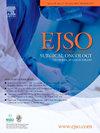Dual-energy CT for predicting progression-free survival of locally advanced gastric cancer after gastrectomy: Insights into tumor angiogenesis
IF 3.5
2区 医学
Q2 ONCOLOGY
引用次数: 0
Abstract
Objectives
To investigate preoperative dual-energy CT (DECT)-derived independent risk factors affecting progression-free survival (PFS) in patients with locally advanced gastric cancer (LAGC) undergoing gastrectomy, and to reveal the underlying histopathologic changes.
Methods
This prospective study included patients who underwent preoperative DECT scan and gastrectomy. Clinical data, DECT-derived morphological characteristics and iodine-related parameters were comprehensively collected. Univariate and multivariate analyses were carried out to identify independent risk factors associated with PFS. The prognostic performance of various parameters was evaluated using the bootstrap-based consistency index (C-index) and time-dependent receiver operating characteristic (ROC) analysis. Kaplan-Meier curves were used to assess the differences in survival analysis. The histopathologic underpinnings of the DECT-based combined parameter for evaluating PFS were explored.
Results
120 LAGC patients (63.3 ± 10.9 years; 94 men) were analyzed. Age, arterial enhancement fraction (AEF), serosal invasion, and tumor thickness were identified as preoperative independent risk factors affecting PFS (all p < 0.05). The combined parameters based on these risk factors achieved a C-index of 0.75, significantly or slightly superior to that of any single risk factor (all p < 0.05) or postoperative pathological staging (C-index, 0.67; p > 0.05). For predicting the 0.5-, 1- and 2-year PFS, the combined parameter had an area-under-the-curve (AUC) of 0.72, 0.77, and 0.74, respectively. PFS significantly differed between patients of high- and low-risks assessed with the combined parameter (p < 0.001). Histopathologically, the combined parameter was associated with tumor microvessel density (r = 0.31, p < 0.001).
Conclusion
The combination of DECT-derived morphological characteristics, iodine-related parameters, and clinical data helped accurately stratify PFS in LAGC before surgery and is associated with tumor angiogenesis.
Clinical relevance statement
Dual-energy CT was promising in the preoperative evaluation of the progression-free survival in LAGC patients after gastrectomy.
双能CT预测胃切除术后局部晚期胃癌的无进展生存:对肿瘤血管生成的见解
目的研究接受胃切除术的局部晚期胃癌(LAGC)患者术前双能 CT(DECT)衍生的影响无进展生存期(PFS)的独立危险因素,并揭示其潜在的组织病理学变化。方法这项前瞻性研究纳入了接受术前 DECT 扫描和胃切除术的患者。全面收集临床数据、DECT衍生形态学特征和碘相关参数。研究人员进行了单变量和多变量分析,以确定与 PFS 相关的独立风险因素。使用基于引导的一致性指数(C-index)和时间依赖性接收器操作特征(ROC)分析评估了各种参数的预后性能。Kaplan-Meier 曲线用于评估生存分析中的差异。结果分析了 120 例 LAGC 患者(63.3 ± 10.9 岁;94 例男性)。年龄、动脉增强分数(AEF)、浆膜侵犯和肿瘤厚度被确定为术前影响 PFS 的独立风险因素(所有 p 均为 0.05)。基于这些风险因素的综合参数的C指数为0.75,明显或略高于任何单一风险因素(所有P均为0.05)或术后病理分期(C指数为0.67;P为0.05)。在预测 0.5 年、1 年和 2 年的生存期时,综合参数的曲线下面积(AUC)分别为 0.72、0.77 和 0.74。综合参数评估的高风险和低风险患者的 PFS 有明显差异(p < 0.001)。从组织病理学角度来看,该组合参数与肿瘤微血管密度相关(r = 0.31,p <0.001)。结论DECT衍生的形态学特征、碘相关参数和临床数据的组合有助于在术前对LAGC患者的PFS进行准确分层,并与肿瘤血管生成相关。
本文章由计算机程序翻译,如有差异,请以英文原文为准。
求助全文
约1分钟内获得全文
求助全文
来源期刊

Ejso
医学-外科
CiteScore
6.40
自引率
2.60%
发文量
1148
审稿时长
41 days
期刊介绍:
JSO - European Journal of Surgical Oncology ("the Journal of Cancer Surgery") is the Official Journal of the European Society of Surgical Oncology and BASO ~ the Association for Cancer Surgery.
The EJSO aims to advance surgical oncology research and practice through the publication of original research articles, review articles, editorials, debates and correspondence.
 求助内容:
求助内容: 应助结果提醒方式:
应助结果提醒方式:


